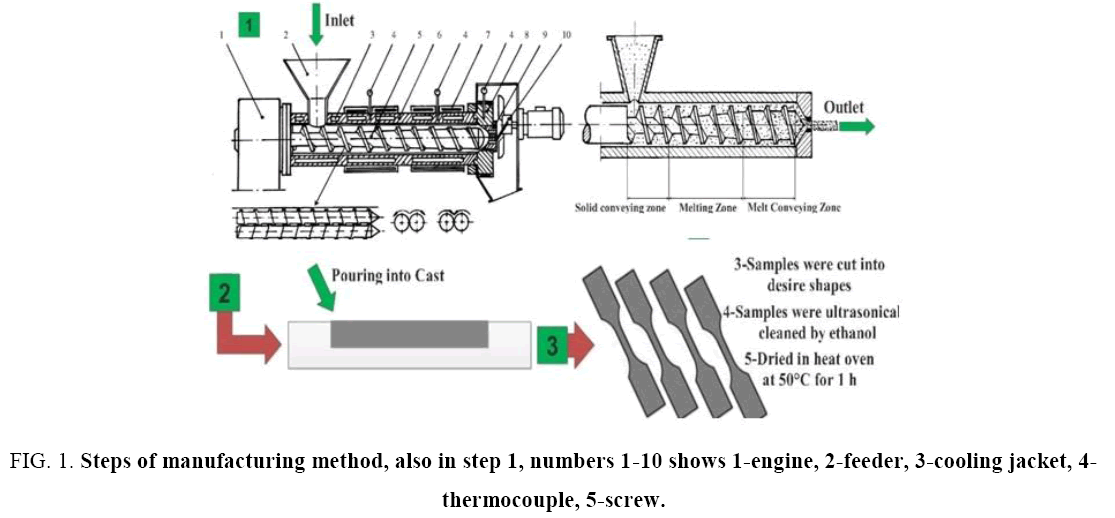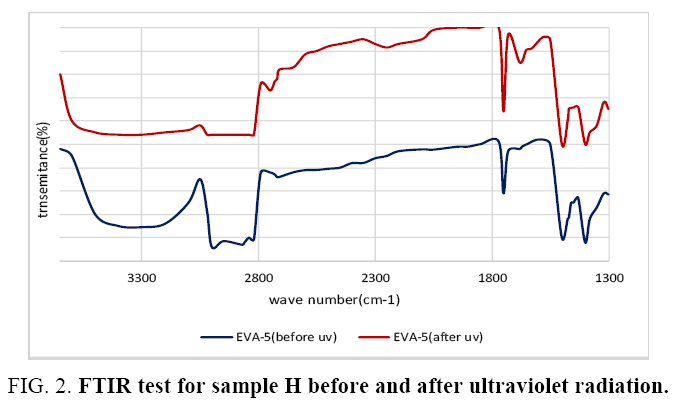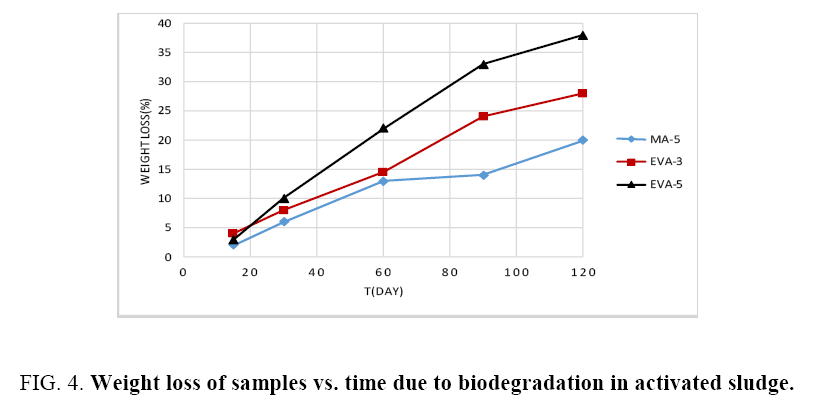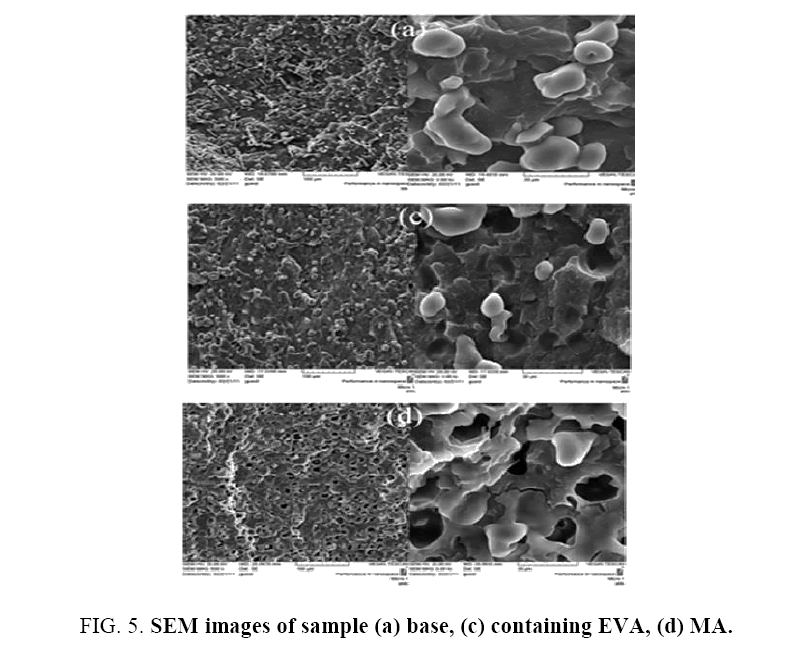Original Article
, Volume: 15( 4)Modification of Polypropylene-Starch Blend by Eggshell Nano-Particle, EVA and Maleic Anhydride to Improve Biodegradability and Thermal Properties
- *Correspondence:
- Mousavi SM, Department of Medical Nanotechnology, School of Advanced Medical Sciences and Technologies, Shiraz University of Medical Sciences, Shiraz, Iran, Tel: +98-7132305410; E-mail: Kempo.smm@gmail.com
Received: November 16, 2017; Accepted: November 22, 2017; Published: November 24, 2017
Citation: Mousavi SM, Hashemi SA, Amani AM, et al. Modification of Polypropylene-Starch Blend by Eggshell Nano-Particle, EVA and Maleic Anhydride to Improve Biodegradability and Thermal Properties. Int J Chem Sci. 2017;15(4):225
Abstract
Starch as an inexpensive and renewable source is used as a filler in plastics industry for about two decades. In current study, the blend of polypropylene and thermoplastic starch is modified by eggshell nano-particles and mechanical property of the prepared samples is investigated through break point and young modulus tests. In order to improve the compatibility between hydrophilic starch and polypropylene, of maleic anhydride and ethylene vinyl acetate are used as a compatibilizer to enhance the dispersion and the interfacial affinity in thermoplastic starch and polypropylene blend. Then the biodegradability and surface morphology of prepared samples is studied considering weight loss, FTIR and SEM tests. Mechanical results showed that strain at break point and Young’s modulus specifications are improved in the prepared samples. The results showed that adding starch to polypropylene increases biodegradability and results lower hydroxyl groups in prepared sample.
Keywords
Starch; Polypropylene; Compatibilizer; Biodegradation; Morphology
Introduction
During the last decades, biodegradable polymers with appropriate mechanical properties have received particular attention as a substitute for synthesis plastics. Currently, starch based polymeric materials have been introduced as a renewable and economical alternative for petroleum based, non-renewable polymeric compounds. Starch as a promising biomaterial, is a carbohydrate compound consisting a large number of glucose units joined by glycosidic bonds. It is one of the most abundant and inexpensive polysaccharide sources, which presents suitable biodegradability property. In presence of suitable plasticizers, starch can be transformed into an amorphous thermoplastic material, that known as thermoplastic starch.
Since humidity influence the mechanical properties of thermoplastic starch, applications of starch are limited [1]. To overcome the poor mechanical properties of thermoplastic starch, it is mixed with synthetic polymers, such as low-density polyethylene, polypropylene and polystyrene [2-4]. Many researchers have focused on modification of thermoplastic starch by polyolefins to improve its biodegradability and mechanical property. Polypropylene as a thermoplastic material is a linear hydrocarbon polymeric compound. It is widely used in packaging, automotive, healthcare application, and communication or electronic industries. However, it is not easily degraded in the environment because of high molecular weight and hydrophobic character. Kaseem et al. investigated the rheological and mechanical properties of polypropylene-thermoplastic starch blend. Although strain at break of the blends was decreased, the Young’s modulus of the blends was improved compared to the base polypropylene [5].
Schlemmer et al. studied the biodegradation of polystyrene thermoplastic starch blend. The results showed that blending polystyrene and thermoplastic starch is an effective technique to achieve suitable biodegradability [6]. The physical and mechanical properties of polypropylene are modified by recycled polyethylene terphthalate and rice bran. Results showed that the prepared composite presents the higher tensile modulus and impact because of filamentous morphology [7]. Pérez et al. investigated influence of starch type and content on thermal properties and morphology of polypropylene-starch blend [8]. The results showed that prepared blend of cornstarch and polypropylene has lower decomposition temperature, due to higher amylose content in cornstarch compared to the potato starch. Corradini et al. studied effect of zein on properties of starch and glycerol blend [9].
The results showed that the use of zein in thermoplastic starch causes a decrease in the water sensitivity and melt viscosity. Li et al. investigated the biodegradability property of thermoplastic starch, low density polyethylene and polylactic acid blend [10]. It is found that thermo plastic starch is degraded more rapidly compared to the native starch. Blending thermoplastic starch with low density polyethylene and polylactic acid increases TPS surface area and increases the biodegradation rate. Shujun et al. investigated the mechanical and thermal property of thermoplastic starch and linear low density polyethylene blend [11]. The FTIR results also indicated that with the addition of maleic anhydride, the compatibility between thermoplastic starch and polyethylene in the blends was truly improved.
From industrial view point, use of inorganic fillers is an applicable and suitable method to improve mechanical and thermal properties of plastics. Among the inorganic fillers calcium carbonate is one of the most abundant biomaterials [12]. It is one of the most commonly used inorganic fillers for thermoplastic polymers, such as poly vinyl chloride and polypropylene [13]. Many researchers have focused on surface modification of CaCO3 particles to increase the polymer–filler interactions, which results the enhancement of blend mechanical properties. Vilela et al. investigated the cellulose and calcium carbonatenano-composites blend and reported an improvement of mechanical properties compared to base cellulose [14]. In this study, the effect of eggshell Nano-particle on mechanical property of the polypropylene–thermoplastic starch blend is studied. Blending starch with polypropylene produces immiscible blends requiring the addition of a compatibilizer to improve interfacial adhesion. In this work, maleic anhydride and ethylene vinyl acetate are used as compatibilizer to improve miscibility of blend with different ratios. Then, biodegradability of the prepared samples is experienced according to the standard tests. FTIR and weight lost methods are considered to investigate biodegradability of the prepared samples. Morphology and particles dispersion in the structure of prepared samples are investigated using SEM images.
Materials and Sample Preparation
Starch supplied from Granking Company was mixed with glycerol in a laboratory scale dual screw extruder and thermoplastic starch was produced. From mechanical view point, addition of glycerol as a plasticizer increases the ductility or elasticity of a starch, which results a decrease in strength and stiffness. The obtained thermoplastic starch was mixed with polypropylene in the dual screw extruder operating at 80 rpm considering ethylene vinyl acetate (EVA) and polypropylene graft maleic anhydride (PP-g-MA) as stabilizer.
The polypropylene as the base material was supplied by Sabic Company. The eggshell slices were powdered in a Ball Mill machine and eggshell Nano-particles were produced in range 70 nm. The main compound in eggshell is calcium carbonate about 95%, phosphate, magnesium carbonate and soluble and insoluble proteins about 5%. The produced Nano-particles were mixed with the prepared starch and polypropylene blend in the extruder. Formulation of samples and processing conditions are presented in Table 1.
| Sample | Compatibilizers | Eggshell | Sample | ||
|---|---|---|---|---|---|
| PP | - | - | 3 | A | A |
| PP-TPS (90/10) | - | - | 3 | B | B |
| PP-TPS (70/30) | - | - | 3 | C | C |
| PP-TPS (50/50) | - | - | 3 | D | D |
| PP-TPS (50/50) | - | - | 0 | PP/TPS | E |
| PP-TPS (50/50) | 6 | EVA | 0 | PP/TPS/EVA | F |
| PP-TPS (50/50) | 6 | EVA | 3 | EVA-3 | G |
| PP-TPS (50/50) | 6 | EVA | 5 | EVA-5 | H |
| PP-TPS (50/50) | 6 | MA | 0 | PP/TPS/MA | J |
| PP-TPS (50/50) | 6 | MA | 3 | MA-3 | K |
| PP-TPS (50/50) | 6 | MA | 5 | MA-5 | L |
Table 1: Composition samples containing various percentages of TPS.
Test method
The mechanical properties of samples, tensile strength and elongation at break, were analyzed according to ASTM-D638 and ASTM D882 standard test methods. FTIR and weight lost methods are considered to investigate biodegradability of the prepared samples. Dynamic mechanical analysis is used to study thermal property of samples. ASTM G21 test was conducted on the prepared samples followed by FTIR test. ASTM G21 is a standard test method for determining resistance of polymeric materials to fungi.
Results and Discussion
Mechanical property
In this research, the mechanical property of the polypropylene and starch blend is modified by eggshell Nano-particles as filler. The Young’s Modulus, tensile stress and elongation at break of prepared sample contains 3% eggshell Nano-particles are compared with the base samples. Young's modulus is a measure to evaluate the stiffness of an elastic material and presents a quantitative criterion to characterize mechanical property of materials. It is defined as the ratio of the loading stress along an axis to the strain along that axis in the range of stress in which Hooke's law holds.
The young’s Modulus for the base (sample D) and modified blends (sample E) are 704.2 and 830.2 MPa, respectively. Also, elongation at break in the D and E samples are 11.4 and 15.5%, respectively. Tensile strength as a main parameter to investigate mechanical property of polymers is defined as the maximum stress that a material can withstand while being stretched or pulled before failing or breaking. The tensile stress of samples D and E are 14.8 and 23.7 MPa based on the ASTM D882 standard test method, respectively. These results prove that adding eggshell Nano-particle to polypropylene and starch blend improves the mechanical property of the mixture. The uniform distribution, interactions and strong interfacial adhesion of CaCO3 particles with starch-polypropylene matrix increases tensile stress, young’s modulus and elongation at break.
Biodegradation property
Biodegradation is defined as conversion of a material into new compounds through biochemical reactions by microorganisms. Currently, starch as a hydrophilic degradable macromolecule is used to produce biodegradable polypropylene composite. The difference between property of starch and polyethylene results in poor compatibility of starch and polyethylene blends. In this section, the performance of maleic anhydride and ethylene vinyl acetate on degradability and compatibility of starch, polyethylene blend is investigated considering eggshell Nano-particles as filler.
Generally, adding compatibilizer prevents the agglomeration of starch granules and increases the biodegradation rate after adding fungus to prepared samples. Polymers are degraded by hydrolysis and oxidation in biological systems. Microorganisms, oxygen, moisture, nutrients, proper temperature range 20°C to 60°C and pH rage 5 to 8 is necessary for biological degradation. ASTM G21 test was conducted on the prepared samples followed by FTIR test in range of 4000 cm-1 to 400 cm-1. ASTM G21 is a standard test method for determining resistance of polymeric materials to fungi.
Water adsorption
This increase is due to the hydrophilic property of nanoparticles and their uniform distribution in the polymer matrix. According to Table, it can be concluded that the increasing of sample Nano egg shell and weight percent increases the water adsorption. Additionally, with comparison of sample (The water adsorption percent can be calculated by Water adsorption percent=[(M0−Md)0] × 100, (1)
Where, m and m1 are m2 the weight of the sample before and after process, respectively.
To perform biodegradability tests, prepared samples are buried in the soil containing activated sludge for 180 days in an interval of 30 days. At the considered intervals, samples were removed and washed perfectly with distilled water, followed by drying at temperature 70°C for two hours. Figure 1 presents the weight loss of prepared samples containing EVA and MA. It was observed that the matrix of all samples is degraded in 120 days, and biodegradability is increased with increasing test time in the soil burial. The results shows that biodegradation of sample contains EVA is more considerable compared to the sample contains MA. Although samples present a same weight loss profile, the weight loss in samples containing EVA and MA is 38% and 22%, respectively.
Figure 1: Steps of manufacturing method, also in step 1, numbers 1-10 shows 1-engine, 2-feeder, 3-cooling jacket, 4-thermocouple, 5-screw.
FTIR Test
Figure 2 shows the FTIR results of samples H and L after and before degradation. Fourier transform infrared spectroscopy test (FTIR) is used to confirm biodegradation of samples by formation of new functional groups or disappearance of groups in the polymer. Absorption peak of hydroxyl and carbonyl groups that occur in range of 3100 cm-1 to 3600 cm-1 and 1690 cm-1 to 1760 cm-1, are considered to investigate biodegradability of prepared samples. Results show a decrease in the hydroxyl groups after microbial treatment. The results show that adding starch to polypropylene increases biodegradability and results lower hydroxyl group content in the prepared samples. This reduction is much noticeable in samples H that contains 5% EVA as compatibilizer compared to MA. Carbonyl peak in the area of 1690 cm-1 to 1760 cm-1 signifies oxidative degradation owing to enzymes secreted by fungi. From the spectra of nano-CaCO3, the broad and strong peak at 1489 cm-1 confirms the presence of calcite, the most stable polymorph of calcium carbonate. In the composite films the presence of CaCO3 peaks along with the peaks of blend gives evidence regarding the formation of the composites. In addition, the results show the lower content carbonyl group in sample containing EVA due to higher oxidative degradation.
A SEM technique is considered to investigate the surface morphology before and after biodegradation of the blend films. Morphology of the polymer blends plays an important role in the properties of the final product, especially their mechanical properties depend on it. The nanostructure analysis of prepared samples is established in Figure 3 after and before degradation. Figure 3 shows that the blend of starch and polypropylene has a porous structure with non-uniform distribution of pores. Since, the interfacial adhesion between starch and polypropylene is poor, phase separation is seen according to this figure. Figure 3 shows the SEM image of blends containing EVA and MA, respectively. Starch contains hydroxyl groups making it an ideal candidate for reactive compatibilization. Thus, hydroxyl functional polymers may be coupled with anhydride functional groups and the mechanical property of blend is improved [15].
In SEM picture of samples, it is noticed that starch particle are embedded within polymer matrix. The results show that the morphology of the blends contains MA is improved due to the improvement in the compatibility between starch and polypropylene and no apparent phase interface is seem between starch and polypropylene. Thus MA is more effective compared to the EVA to create a homogenous structure and bending polypropylene and starch particles before degradation. It is appeared that the matrix is destroyed in all samples, particularly samples containing EVA that starch groups have been degraded and omitted from matrix structure.
Thermal property
Dynamic mechanical analysis (DMA) is used to study and characterize thermal property of polymers. One important application of DMA is measurement of the glass transition temperature of polymers. Amorphous polymers have different glass transition temperatures, above which the material will have rubbery properties instead of glassy behaviour and the stiffness of the material will drop dramatically with an increase in viscosity. At the glass transition, the storage modulus decreases dramatically and the loss modulus reaches a maximum. Another common test method to obtain glass transmission temperature involves measuring the phase angle at low constant frequency versus temperature. A prominent peak in tan(δ) appears at the glass transition temperature of the polymer. Generally, increasing the plasticizer content shifts the glass transmission temperature of the starch rich phase toward the lower temperature. Figure 4 shows the loss modulus and tan(δ) in prepared samples E, F, I, and J. As can be seen in Figure 4 the prominent peak in tan(δ) appears around 10°C and 100°C in the sample E that contains TPS and PP. Figure 4 depicts the loss modulus and tan(δ) in the sample F that contains TPS, PPand EVA as compatibilizer. This figure illustrates that adding EVA to the base sampledecreases glass temperature from 100°C to 70°C, while glass temperature of polypropylene remains constant. Increasing compatibilizer shifts glass transient temperature of the starch rich phase toward the lower temperature. Thus, compatibilizeris entered into the starch phase (Figure 5).
Formation of hydrogen bonds between the carbonyl groups in the compatibilizer compound and hydroxyl groups in starch cause relative compatibility between starch and compatibilizer. Adding PP-g-MA to the base samples decrease glass temperature to 62°C. Chemical reactions between anhydride groups of PP-g-MA and hydroxyl groups of starch lead to increase interaction between two phases, which results in better mixing. These results show that starch is more compatible with PP-g-MA and it increases elasticity of sample. In addition, results represent that compatibilizer compounds do not have any effect on glass temperature of polypropylene.
Conclusion
Dispersion of nanoparticles in the samples were investigated by TEM images. The results show perfect distribution of eggshell nanoparticles in the polymer matrix. It can be also concluded that increasing the amount of starch and eggshell nanoparticles gives rise to increase in water absorption which is because of increment in hydrophobicity and polarity of the polymer matrix. Besides that, absorption of water can accelerate the degradation of starch. Fungus cultivation test was also performed to investigate biodegradation of PP/TPS composites with various mass ratios.
Comparing SEM images of samples before and after cultivation of fungi shows a porous matrix after degradation which means fungi have a great influence on this process. Another method that confirms degradation of samples by fungi is FTIR test. Reduction in intensity of the peaks corresponding to hydroxyl groups shows the effect of oxidative degradation on samples owing to secreted enzymes by fungi. To conclude, all these results show that PP-g-MA and EVA are two appropriate compounds that accelerate biodegradation process.
References
- Ferreira WH, Khalili RR, Figueira MJ, et al. Effect of organoclay on blends of individually plasticized thermoplastic starch and polypropylene. Indus Crops and Prod. 2014;52:38-45.
- Rodriguez-Gonzalez FJ, Ramsay BA, Favis BD. High performance LDPE/thermoplastic starch blends: A sustainable alternative to pure polyethylene. Polym. 2003;44(5):1517-26.
- Bardi MA, Machado LD, Dias DB, et al. Influence of thermoplastic starch plasticized with biodiesel glycerol on thermal properties of PP blends. J TherAnalyCalorimet. 2009;97(2):565-70.
- Pimentel T, Duraes J, Drummond A, et al. Preparation and characterization of blends of recycled polystyrene with cassava starch. J Mater Sci.2007;42:7530-6.
- Kaseem M, Hamad K, Deri F. Rheological and mechanical properties of polypropylene/thermoplastic starch blend. Polymer Bulletin. 2012;68(4):1079-91.
- Schlemmer D, Sales M, Resck IS. Degradation of different polystyrene/thermoplastic starch blends buried in soil. CarbohydrPolym.2009;75:58-62.
- Oromiehie AR. Mechanical properties and water absorption behavior of rice husk flour filled polypropylene composites. Iranian Polymer J. 2006;15(9):757-88.
- Mónica A, Pérez R, Bernabé L, et al. Polypropylene/starch blends. Study of thermal and morphological properties. J ChilChem Soc. 2013;pp: 1643-6.
- Corradini E, Carvalho AJ, Curvelo AA, et al. Preparation and characterization of thermoplastic starch/zein blends. Mat Res. 2007;10(3):227-31.
- Li G, Sarazin P,Orts WJ, et al. Biodegradation of thermoplastic starch and itsblends dwithpoly(lactic acid) and Polyethylene:Influence of Morphology.Chem Phys. 2011, 212, 1147–1154.
- Shujun W, JiugaoY, JinglinY. Preparation and characterization of compatiblethermoplastic starch/polyethylene blend.PolymDegrad Stab.2005;87:395e401.
- Reede RJ. Carbonates: Mineralogy and Chemistry. Miner Soc Am.1983;11:227-64.
- Akovali G,Akman MA. Mechanical properties of plasmasurface-modified calcium carbonate-polypropylene composites.Polym Inter. 1997;42:195-202.
- Vilela C,Freire CSR, Marques PAAP, et al. Synthesis and characterization of new CaCO3cellulosenanocomposites prepared by controlled hydrolysis of dimethylcarbonate. CarbohydrPolym. 2010;79:1150-6.
- Saiah R, Sreekumar PA, Selvin Thomas P. Thermoplastic andThermosetting Polymers and Composites. Chapter 2: Biofiber Reinforced Starch Composites. Nova Science Publishers Inc. 2011;pp:37-84.





